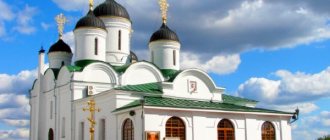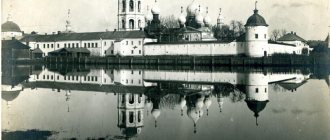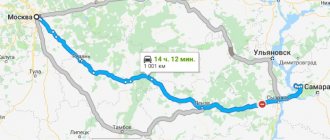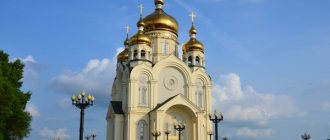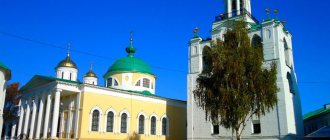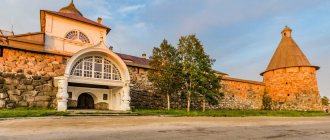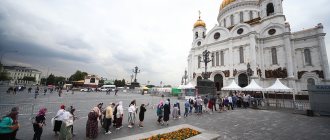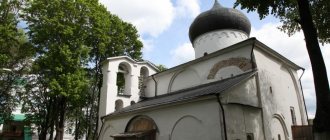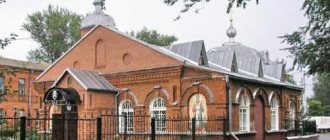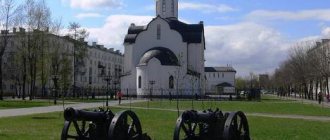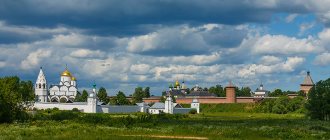Holy Trinity Convent
The relics of Saints Peter and Fevronia are buried here.
History has preserved to this day the legend of the love of the Murom prince and a simple girl who cured him of a serious illness. They had to endure persecution and hardships before this couple stood at the head of the city and earned the love and respect of the inhabitants. In their old age, Peter and Fevronia took monastic vows and bequeathed to be buried together.
According to legend, they died at the same time, on July 8, 1228, and the story of their lives gave rise to the aphoristic phrase: “They lived happily and died on the same day.”
Current status of the Spaso-Preobrazhensky Monastery
The Spaso-Preobrazhensky Monastery (Murom) is currently operational, and its territory and facilities have been completely restored after the Soviet period.
The revival of the monastery occurred thanks to the creation of a board of trustees and further financial assistance from Interros Investment Company, Gazprom PJSC, RIK-WEST Investment Company, SUEK Group, Metropol IFC, as well as donations from capital and St. Petersburg entrepreneurs.
The monastery has retained a communal charter, which provides for the monks to live together in the Spassky Monastery, as well as to conduct economic activities.
Since 2013, the Transfiguration Monastery (Murom) has become the general administrative center of the newly created Murom diocese. At the moment, the abbot of the monastery is Nil (Sychev), Bishop of Murom and Vyaznikovsky.
Other holy places of Murom
Opposite the Holy Trinity is another main attraction of the city - the Annunciation Monastery. It was founded by Ivan the Terrible after the capture of Kazan in 1552, on the burial site of Prince Constantine and his family, who were also canonized for the spread of Christianity on Murom soil.
At the intersection of the main streets of the city there is the Murom Church of the Ascension of the Lord. This temple, founded in the 16th century, was half dismantled and rebuilt into a school in the post-revolutionary period. Only in the last two decades, restoration work carried out made it possible to return the church to its former appearance.
The Red Vozdvizhenskaya Church was rebuilt several years ago on the site where a convent was located in the 12th century. Several centuries later, a church was built here, which existed until the Soviet period.
At all times Krasnovodskaya the Church enjoyed the special attention of the Moscow princes, exempt coming from many state taxes.
Another epic character glorified the ancient city - Ilya Muromets. Not everyone knows that this is a real historical hero who fought for Rus' and the Orthodox faith. For his exploits he was canonized by the church. His relics are kept in the Kiev Pechersk Lavra, but a piece of them was transported to Murom; you can venerate the shrine in the Spaso-Preobrazhensky Monastery.
In the city Park, the hero of epics and tales Ilya Muromets in a symbolic place on the Oka river embankment is a monument — just where in ancient times was the border of the Russian land.
Saint Juliana Lazarevskaya, who is also considered the patroness of the family, also lived in Murom. She and her husband lived happily in love and harmony, gave birth to many children. All thoughts and actions of Juliana were devoted to works of mercy, helping widows and orphans. You can venerate this saint in the Murom St. Nicholas Church, located on the banks of the Oka River.
Murom shrines
For the fourth time on July 8, Russia celebrates the Day of Family, Love and Fidelity. This day was dedicated to the feast of St. blgv. Princes Peter and Fevronia of Murom, patrons of family well-being. But besides these well-known saints, the relics of another amazing ascetic also rest in Murom - St. Right. Juliana the Gracious, pious wife and mother of many children. And outside the city, by the river, “the same hill where Ilya Muromets threw logs to measure the depth of the Oka” has been preserved. Our correspondent visited Murom, see the photo report:
In the center of Murom - where Moskovskaya Street begins and the local "Arbat" is located - a scattering of peeling and attractive houses of the 19th century - you can eat inexpensively in one of the many cafes, and then go to the local shrines. Landmarks - a monument to Lenin and an unusual-looking tower - this is the first water supply system in the Nizhny Novgorod region
Behind them, if you turn left, are two monasteries. The first of them is Trinity Women's. Here in the central nave of the Trinity Church rest the relics of Sts. Peter and Fevronia - Orthodox patrons of family and marriage
Hagiographic icon of Saints Peter and Fevronia, from the Murom Local History Museum
The territory of the monastery, covered in flowers, is filled with female pilgrims who come here to pray for family well-being.
Sewn cover on the relics of saints
The church shop is replete with brochures about Orthodox marriage, and prayers “for the granting of marriage.” In the photo: fresco at the entrance to the temple - The Last Judgment
Across the road from Trinity is the Annunciation Monastery.
The relics of the Murom noble princes and ascetics are kept here: St. Basil, the first bishop of Murom, Equal-to-the-Apostles Constantine, his wife Irina and children Mikhail and Theodore, Murom wonderworkers
Hagiographic icon of the Murom noble princes
If you go down from the monastery to the Oka River, on the steep bank you can see the yellow temple of St. Nicholas the Wonderworker. Locals call him “Nikola-wet”.
The relics of Saint Juliana of Murom, another Murom ascetic, patroness of family and marriage, are kept here.
If you are traveling with children, they may be interested in seeing “the place where Ilya Muromets was born.” This epic character is now associated by many with the venerable ascetic Ilya of the Kiev-Pechersk Lavra, whose relics rest in the Near Caves of the Kiev-Pechersk Lavra. In the photo: a model of the boat on which Ilya Muromets may have walked along the Oka River
The riverbed of the Oka is the ancient border of the Vladimir principality. Across the river is the once hostile Nizhny Novgorod Land, and there are Mordovians, Mari and Volga Bulgars...
Getting to the “place of birth” is not easy, but local residents, proud of their “great fellow countryman,” will be happy to show you “the same hill where Ilya threw logs to measure the depth of the Oka River,” Priokskaya Street in the suburb of Murom - Korocharovo, where “he was born and Ilya Muromets spent his childhood.”
Actually, on this street there is already a worship cross, a bathhouse and a souvenir stall (absolutely not a church one). “But they put the cross on the wrong hill! - Karacharovites complain. “In fact, he stood to the left” - and they busily point a finger at the next hill, which is no different from the first
There is practically nowhere to stay in Murom; several hotels offering their services are extremely expensive, but there is a pilgrimage center and a hotel at the Spaso-Preobrazhensky Monastery. You can find it at the address Vladimir region, Murom, st. Lakina, house 1. For details, call 8-(49234) - 3-14 -76
Text Dmitry REBROV Photo Ekaterina STEPANOVA
print version
Tags:
Church holidays Holy Shrines
Tour for 2 days! Shrines of Murom!
We invite you to visit the city of Murom, whose name is associated with a huge number of epics and chronicles, where, starting from 862, the Murom lands are glorified with their history and the people who lived here - the invincible hero Ilya Muromets, the faithful spouses Peter and Fevronia, the Holy Righteous Juliana of Lazarevskaya. During the trip, you will learn the main events of the thousand-year history of the city of Murom, how the monasteries you visited arose and were revived, and hear stories about the Saints glorified on the Murom land. Here you can venerate Orthodox shrines and take a bath in the springs.
In a programme:
1st day.
— Arrival in the city of Murom. Check-in at the modern hotel in the city of Murom “Svyatogor”. Double rooms for you. It is possible to order a room with a double bed or a single room (with extra charge). It is planned to share accommodation for those traveling alone, according to the principle: women to women, men to men (without additional payment).
— Lunch at a city cafe.
— Sightseeing tour of the city of Murom with a walk along the beautiful embankment of the Oka River. You will see the roofed Kosmo-Demyansk Church, unique in its architecture, built in the 16th century in honor of the victory over Kazan. On the observation deck of Oksky Park you will see the monument to Ilya Muromets, admire the beautiful view of the Trans-Oka region and the famous Murom cable-stayed bridge. You will visit the historical center of the city, where ancient merchant houses and a water tower have been preserved from the 19th century.
— Visit to the St. Nicholas Embankment Church (aka St. Nicholas the Wet), built in the 18th century in the name of St. Nicholas the Wonderworker, as the guardian and patron of fishermen. It’s not for nothing that the church is located on the banks of the Oka River. At the foot of the temple, the Nikolsky spring flows, which is considered healing in the city. There is an opportunity to take a dip and get some water.
— Visit to the Holy Trinity Convent, built in the 17th century. Here you will see the richly decorated five-domed Trinity Cathedral. It is given a special elegance by tiles depicting herbs, strange animals and birds. In the Trinity Church you will see icons embroidered by the goldsmiths of the monastery (from ancient times one of the monastic traditions was the art of embroidery with gold, silver and precious stones). People come to the Trinity Cathedral to venerate the relics of the patrons of Orthodox marriage - Saints Peter and Princess Fevronia, because they are an example of marital fidelity and love, which they preserved throughout their lives. Also on the territory of the monastery you will see the unique hipped Kazan gate church, a bell tower, and a wooden church in honor of St. Sergius of Radonezh from the early 18th century, the domes of which are covered with alder ploughshares, which shimmers silver in the sun.
— Visit to the Holy Annunciation Monastery, built in the 16th century by order of Ivan the Terrible. In the Annunciation Cathedral of the monastery there is the oldest surviving iconostasis in Murom, consisting of 6 tiers, which was installed in the 18th century. Here you can venerate: the reliquary with the relics of the blessed prince Konstantin (Yaroslav) Svyatoslavovich, with whom the baptism of the Murom land is associated, and his sons Mikhail and Fedor; the stunning beauty and power of the miraculous Iveron Icon of the Mother of God, which people thank with gifts and decorations for the quick and miraculous hearing of prayers. On the territory of the monastery there are also ancient burials, among which is the grave of the elder hieromonk Apollonius, on the site of which a chapel was erected, where you can pray for the elder and ask for his prayers for yourself and your loved ones, because they say that Apollonius hears them very well and quickly fulfills them.
— A visit to the oldest and most beautiful Spaso-Preobrazhensky Monastery, the appearance of which is associated with the 10th-11th centuries, the first mention of it is reflected in the “Tale of Bygone Years”. The monastery houses the miraculous Athonite icon of the Mother of God “Quick to Hear,” a statue of Ilya of Murom with a piece of his relics, and a cross with a piece of the Holy Cross. On the territory of the monastery you can visit the “Life-Giving Spring” and plunge into a font with artesian water. A stone brought from the banks of the Israeli Jordan River was installed here.
— Dinner at the hotel.
— Free time in the city of Murom.
2nd day.
— Breakfast at the hotel.
— Upon request (on your own) at 08.30, visit the morning prayer service at the relics of Peter and Fevronia in the Holy Trinity Monastery (Trinity Cathedral).
— Optional (on your own) visit to the Murom Historical and Art Museum. There are exhibitions on display that tell the history of the city of Murom. You will see unique and most valuable exhibits of ancient Russian art, reflecting the originality of the culture of medieval Murom: archaeological objects, icons, facial embroidery, books, copper plastic and silver from Murom churches. Also at the exhibitions you can get acquainted with ancient objects of the everyday life of townspeople, where you can see: numerous chests and chests with coins, boxes and caskets with decorations of the 17th-19th centuries, silverware and porcelain, cute little things on the ladies' mirror, popular musical instruments "in living room,” a luxurious kerosene lamp next to the sideboard, entertaining things “in the men’s office,” lovely games, toys and books from our great-grandparents’ nursery. The museum's Art Gallery, which displays collections of Russian and Western art of the 17th and early 20th centuries, will not leave you indifferent.
— Visit to the Holy Resurrection Convent, which, according to legend, was built on the site where the country palace of Prince Peter and Princess Fevronia stood. In the churches of the monastery you can venerate such shrines of the Murom land as: the revered image of the Most Holy Theotokos “Joy of All Who Sorrow”; The Feodorovskaya Icon of the Mother of God with a centuries-old history; an icon with a particle of relics and the shoe of Spyridon of Trimifuntsky, brought from Greece, from the island of Corfu; an ark with a particle of the relics of St. Nicholas the Wonderworker; icon of St. Mitrophan of Voronezh with a reliquary; an ark with particles of the relics of Vladimir-Suzdal and other Russian saints.
— A visit to the Bishop’s courtyard of the Archangel Michael Church in the village of Lazarevo - the place where Saint Juliania Lazarevskaya of Murom labored and was later buried, who during her lifetime was glorified by her deeds of mercy. Today people come to the courtyard to venerate the relics of the holy righteous Juliana Lazarevskaya and ask her for well-being in the family.
— Visit to the village of Karacharovo - the birthplace of the famous hero Ilia Muromets. Ilya Muromets is a warrior hero, people's defender and the embodiment of strength. He was canonized by the church as St. Elijah of Pechersk. In Karacharovo there is also one of the few churches in Russia consecrated in honor of the saints - Guria, Samon and Aviva - patrons of the family. The Holy Spring with a font is also located here. You can take a dip and take some water with you.
— Lunch in a city cafe – 350 rubles. (optional).
— Departure for Moscow.
Cost for children from 7 to 14 years old inclusive and groups of 5 people - 5500 rub.
Cost for children up to 6 years old inclusive - 3900 rub.
You can book an excursion to Murom for your group. The cost is calculated individually.
Spaso-Preobrazhensky Monastery in Murom Diocesan monasteries of the Russian Orthodox Church
In the chronicles, the “monastery of the Savior on the forest” is mentioned in 1096. In the 12th – 13th centuries, the Murom princes were buried in the monastery. According to legend, the holy blessed prince Peter, the husband of the blessed princess Fevronia, took monastic vows at the monastery. Another bright page in history is connected with Ivan the Terrible. In 1552, the tsar led a campaign against Kazan. One of the routes of his numerous army lay through Murom.
The young tsar made a vow: if he takes Kazan, he will erect stone churches in Murom. The Emperor kept his word. By his decree, in 1555 the Transfiguration Cathedral was erected in the monastery in the city. The Russian Tsar donated church utensils, vestments, icons and books to the new temple.
In the second half of the 17th century, the second warm stone Church of the Intercession was built in the monastery. The lower floor of this church housed a cookery, bakery, and chambers.
The reign of Catherine the Great, who issued a decree according to which the monasteries were deprived of property and land plots, did not have the best effect on the life of the monastery. However, the Spaso-Preobrazhensky Monastery survived. This fact was facilitated by one very important event - from Holy Mount Athos in 1878, the rector Archimandrite Anthony (Ilyenov) brought the icon of the Mother of God “Quick to Hear” to the monastery. Since then, it has become the main shrine of the monastery.
In 1891, a three-story fraternal building was erected on the territory of the monastery.
The monastery was closed in 1918 due to accusations against Soviet power. In the 1930s, the territory of the monastery was occupied by the military department, and a communications training regiment was located in the monastery buildings. The military unit left the territory of the monastery in the spring of 1995. Already at the beginning of the summer of the same year, the Holy Synod of the Russian Orthodox Church decided to reopen the Spassky monastery in ancient Murom.
In 1990, on the eve of the 900th anniversary of the Spasskaya Monastery, Academician D.S. Likhachev turned to His Holiness Patriarch of Moscow and All Rus' Alexy II with a petition for the revival of the most ancient shrine. As a result, a decision was made to evict the military unit. After her departure, the extent of the devastation of the monastery became almost more obvious.
The young monk Kirill (Epifanov), appointed future abbot, was then given a blessing to restore the shrine. In essence, it was necessary to build the monastery anew, which was associated with extreme difficulties, including organizational and material ones. And yet, the restoration process, initially begun by the efforts of very few people, led to the revival of the ancient monastic shrine. This was largely facilitated by the support provided to the monastery by the current Chairman of the Accounts Chamber of the Russian Federation, Sergei Stepashin, who in 1994 organized the Board of Trustees for the restoration of the Murom Spaso-Preobrazhensky Monastery.
This was preceded by the holding of a conference of the Association of Control and Accounting Bodies of Russia in the summer of 2003 in Vladimir. As a cultural program, its participants were invited to familiarize themselves with the sights of the region, including the Spaso-Preobrazhensky Monastery of Murom. The degree of destruction of the oldest Russian monastery made a deep impression on visitors. It turned out to be impossible to remain on the sidelines, and, having returned to the capital, the conference participants conveyed to the Chairman of the Association S.V. Stepashin an appeal from the Archbishop of Vladimir and Suzdal Evlogy with a request to help restore the monastery. The head of the Accounts Chamber of the Russian Federation readily responded to this request.
Soon like-minded people were found. The auditor of the Accounts Chamber, S. N. Ryabukhin, worked in the past on the construction of the Ulyanovsk aviation complex. It was decided that he would be the best person to organize restoration work. Thus, the Board of Trustees was created to recreate the Spaso-Preobrazhensky Monastery.
It is noteworthy that the trustees did not create any extra-budgetary charitable foundations. It was decided that charitable donations would be sent directly to the monastery’s account. The first to respond were Gazprom, Interros, RIK-WEST, IFC Metropol, Siberian Coal Energy.
During the period of active restoration work, the Transfiguration Cathedral was restored, the Intercession and All Saints churches were completely restored, a fence was erected and the gate church of St. Kirill Belozersky. The fraternal building was completely renovated and refurbished. A chapel to the Great Martyr was erected on the territory. St. George the Victorious (2002), new gate church of St. Sergius of Radonezh (2005), chapel of St. Xenia of St. Petersburg (2006), chapel in honor of the icons of the Mother of God “Life-Giving Source” and “Spreader of Bread”. The last of them is located at the bakery, where delicious and aromatic bread products are baked. On the territory of the monastery there is a chapel-ossuary where the remains of monks and Murom citizens buried in the monastery are kept; chapel in honor of St. Nicholas the Wonderworker.
On the territory of the monastery, with the blessing of Archbishop Evlogii of Vladimir and Suzdal, the Murom Orthodox Theological School named after His Holiness Patriarch Pimen was opened. On the initiative of Abbot Kirill, the Murom Orthodox Gymnasium of St. Elijah Muromets. Initially, it was also located on the territory of the monastery. In 2013, a separate building for high school students was built in the city of Murom on the street. Moscow.
In 2013, the Murom and Vyaznikovsky diocese was formed, separated from the Vladimir diocese. From that time on, the monastery also became the administrative center of the newly formed diocese. The rector of the monastery is currently Bishop Nil of Murom and Vyaznikovsky.
But a monastery cannot be imagined without the people who inhabit it. The center of monastic life is prayer. The brethren spend most of their time praying in a temple or cell. Prayer during divine services is traditionally revered above cell prayer (except for special cases of God's chosen one).
In the life of a monastery resident, work is inseparable from prayer. Monastic work is sanctified by prayer. Today the brethren are busy with a variety of obediences.
In the monastery there is a prosphora on which the inhabitants of the monastery work. Prosphoras are baked both for the monastery itself and for the parish churches of Murom.
The brethren of the monastery are also engaged in agricultural activities. A small vegetable garden is located right on the territory of the monastery. Vegetables are grown on it
Cherepovets - Karacharovo (590 km) - Murom (170 km) - Arzamas (270 km) - Diveevo (60 km) - Tsyganovka (15 km) - Cherepovets
………………………………………
Tour dates: September 4-5
………………………………………
TOUR PROGRAM
A unique program where you have the opportunity to get acquainted with the most important shrines of Murom, Diveevo, Karacharovo and Arzamas in two days. We will visit ancient Murom. This city is the birthplace of the patrons of marriage: Peter and Fevronia. We will visit the Seraphim-Diveevo Convent and walk along the groove of the Virgin Mary, and take a trip to the holy springs in Tsyganovka, to the very border of the Republic of Mordovia. We will visit the homeland of Ilya Muromets and see the beautiful St. Nicholas Monastery, which is located in the city of Arzamas.
Day 1. Departure. (Friday).
— Cherepovets — 21:00, railway station.
- Vologda - 23:00, shopping center "RIO".
Day 2. (Saturday).
— Arrival in the village of Karacharovo (Cherepovets - Karacharovo 590 km).
— The Chapel of Ilya Muromets is a small log chapel that stands below the hill, to the left of the Trinity Church. According to legends, the first temple on this site was built by the hero himself. Muromets pulled oak logs for the foundation from the waters of the Oka.
— Source of Ilya Muromets. According to legend, a source of holy water opened when a heroic horse hit the ground with its hoof. There is a font next to the source, where everyone is allowed. The main thing is to have a cross with you. also buy souvenirs on site in your free time.
— Visit to Trinity Church. The temple on the hill dates back to 1828. During Soviet times, the building fell into disrepair. But not so long ago, local authorities took up its restoration. Next to the temple there is a bell tower, erected with money from the village residents.
— Visit to the Temple of Guria, Samon and Aviv. This small white stone structure was built in the middle of the 19th century on the initiative of the Murom tradesman Gury Sintsov. is kept here - an icon with the relics of St. Elijah of Muromets. The descendants of the hero ordered it with their savings. And a piece of the relics was brought from the Kiev Pechersk Lavra.
— Transfer to Murom (Cherepovets — Murom 170 km).
— Early lunch.
— Sightseeing tour, with inspection of 3 active monasteries, such as:
— Spaso-Preobrazhensky is one of the oldest in Murom and modern Russia;
- Trinity , in which the relics of the holy noble princes Peter and Fevronia rest;
- Annunciation , in the cathedral church of which the baroque iconostasis of the late 18th century has been preserved. You will walk through Oka Park and visit the Observation Deck overlooking the mighty Oka and the surrounding area, admire the Zaoksky meadows and see the monument to Ilya Muromets , walk along the embankment and see one of the most beautiful cable-stayed bridges in Russia.
- Check into a hotel. Dinner.
_____________________________________________________________________
Day 3 (Sunday).
— Time for breakfast.
— Departure to Arzamas (Murom — Arzamas 270 km).
- Sightseeing tour of Arzamas , which contains a huge number of shrines - the Miracle Cross, the miraculous carved icon of Nicholas of Mozhaisk, the icon of the Mother of God “Joy of All Who Sorrow”, “The Sign”, the myrrh-streaming icon “Seven Shooter”, “Helper in Childbirth” (for conception and birth of children).
— Visit to the Resurrection Cathedral , which was painted using the rare Grisal technique (black, white and brown three-dimensional images of saints). There are only two such cathedrals left - in Arzamas and in Italy.
— Visit to the Nikolsky Convent. In the lower church there is the Miraculous Icon “Deliverance from the Troubles of the Suffering” (helps to get rid of troubles in life), the icon of the Intercession of the Most Holy Theotokos.
- Departure to Diveevo (Arzamas - Diveevo 60 km).
— Lunch at a city cafe.
— Excursion around the monastery. Once, after a night prayer vigil in the Kiev-Pechora Lavra, Mother Alexandra had a vision of the Most Holy Theotokos, who asked to find a place to found a new great monastery. In 1760, Mother walked from Murom to the Sarov Hermitage and stopped to rest in the village of Diveevo, where she again had a vision of the Mother of God, who announced to the nun that “this is the very place.” In 1773-1774, Alexandra, using her own funds, built the foundation of the Kazan Church, which became the first building of the monastery.
— Visit to the groove of the Virgin Mary (founded in 1829 by St. Seraphim of Sarov). Holy relics of St. Seraphim of Sarov; St. rights Alexandra, St. Martha and St. Helena.
— Visiting the springs: the saint is right. Alexandra and the Iveron Icon of the Mother of God. Opportunity to swim and get water.
— Seraphimo — Diveyevo Monastery, Trinity and Transfiguration Cathedral, Kazan Church.
— Visit to the holy spring of St. Seraphim of Sarov in Tsyganovka. Bathing in a spring where numerous healings have been recorded.
— Departure to Cherepovets (Diveevo — Cherepovets 820 km).
Day 4 . (Monday).
Arrival in Vologda at 07:00, in Cherepovets 09:00 (approximate time).
_____________________________________________________
THE TOUR PRICE INCLUDES: - bus travel; — excursions according to the program; — guide and accompanying services; — meals according to the program (1 breakfast, 2 lunches); — accident insurance. _____________________________________________________
TOUR COST:
7,200 rub. - adult
7,100 rub. - preferential
Interesting facts and legends
- According to various sources, it was on the territory of the monastery that the baptism of the Murom pagans took place.
- The Spaso-Preobrazhensky Monastery (Murom) is the second oldest after the Kiev-Pechora Lavra and has a history of almost a thousand years.
- The names of the holy spouses Peter and Fevronya are inextricably linked with the life of the Spassky monastery. The holy prince was tonsured a monk in this monastery. He died there. This event is marked by a monument to the holy princes and hagiographic frescoes.
